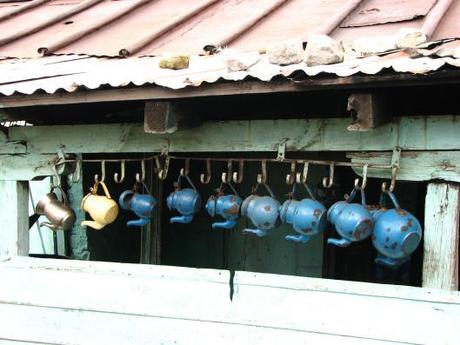
Cultural (Chai) Wars by Robynn
It’s time to speak out. The writers and editors here at Communicating Across Boundaries have been silent on the subject for far too long. But that silence is over. For the record, let it be known, this is the time for clarity and decisiveness. It is the time to speak truth. As a society we’ve been duped. We’ve been deceived. We’ve been kept in the dark. Normally Marilyn and I reluctantly write on these types of issues. Our cross-cultural training demands sensitivity and respect. We’ve been well versed in appreciating value differences, in respecting nuance and cultural norms and conventions.
However, having said all that, sometimes things are not just different they are plainly and universally wrong. Under those circumstances, in those specific situations it is not only appropriate, it is necessary–our prophetic mandate–to identify the wrong and to bring it out into the light.
Today is that day.
Chai is chai. It is a particular beverage. It is not the mamby-pamby, shallow hearted, skim milk based, foam topped, overly cinnamoned, limply spiced, paper cupped drink you’ve been trained to think it is. It is not available in grocery stores in tetra pack boxes. It cannot be reduced to a small mesh tea bag. Merely mixing cinnamon and a pinch of cardamom into the tea bag and sealing it in a box with a fancy label doesn’t make it chai. It cannot be pimped in packaged plastic cups that are hidden in the depths of a cold machine and then punctured and perforated and dribbled into the meaningless cup below
Chai, true chai, is an experience. It’s a marvelous marriage of milk and water and dark tea and sugar and spices. It takes time and love to make the complexities of flavours shine. The equipment needed is simple: a pot, a spoon, a strainer. Although there are variations on mixing methods and spices, one thing is certain, chai is an event.
In South Asia when a guest comes to visit, or a friend pops in, chai is served. Hospitality is incomplete without the warm ritual of chai. Hearts are better shared with a cup of chai in your hand. It’s the beverage that melts the heart’s reserve. Disappointments and sorrows are more keenly lamented over hot chai, strained and steaming. Celebrations and common joys are incomplete without fragrantly spiced chai.
Chai has meaning and hidden complexities. You drink chai with someone you are at peace with. If there is friction or betrayal at work in a relationship, that person is not served chai. If ever you hear, “They didn’t even serve me chai!” you can know there is something a wry in that relationship. Chai means reconciliation. It means harmony and restored friendship.
Chai is served at engagement ceremonies, at weddings, after a baby is born, after the news that someone has died. Chai is served when family comes to visit, or a neighbor comes to gossip. It’s served at church. When you go for a picnic you bring chai. First thing in the morning, last thing in the evening, chai. People drink it at sporting events, at the train station, at the airport, at school functions, at business meetings. When a contract is agreed on, and the papers are signed, the deal is sealed with chai. Whenever a house is sold, whenever a bank loan is negotiated, whenever a marriage is arranged there is chai. Shopping for saris, for silk, for carpets, for bangles, for pots and pans? Undoubtedly you’ll be served chai.
It’s served in china teacups, in small ceramic bowls, in little disposable clay cups. In Pakistan it used to often come in a colourful enamel tea pot, green or beige or blue. When it’s especially hot, mothers pour their chai into the saucer, they blow on it gently to cool it for their child.
The elderly and the very young drink it. The sick, the lame, the robust all drink it. The broken hearted and the elated drink it. The upper classes drink it. The disenfranchised drink it. It’s the drink of community, it’s the beverage of unity.
You may continue to place your order for faux chai through your car window to the voice, crackling and distant, in the small box. You can rummage through your coin purse to procure the correct change before you, “see (them) at the window.” You have all the freedom in the world to specify decaffeinated, or 2% milk, or no foam. But know this: the drink you are consuming, the beverage you are sipping, may in fact be delicious, but it is not chai.
Recipe for Chai
(serves two—-chai can be had on your own, it’s a meditative drink that way, but it’s always better had with a friend or seven)
1 cup of whole milk
1 cup of water
1 tablespoon of loose leaf tea (Liptons Red Label, or Taj Mahal)
2 heaping teaspoons of sugar (or to taste)
2 pods of cardamom, broken
1 inch of cinnamon stick, broken
½ inch of fresh ginger grated or chopped*
1 pinch of black pepper*
Bring water and milk and spices and sugar to a boil. Add tea leaves. Simmer 2 or 3 minutes until it’s the wonderful warm proper rich color of chai. Strain into cups or a teapot . Best served with something sweet and something savory. (*ginger and black pepper are only ever added during the winter! Summer chai is minimally spiced with a titch of cardamom and cinnamon.)
We, the writers at Communicating Across Boundaries, rarely ask you to share our posts. But this one? This one you need to share. Sincerely, the purveyors of real and fine chai.
Picture Credit: the incomparable Jason Philbrick!

